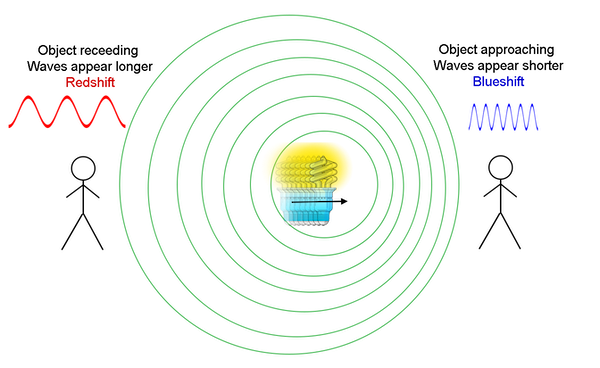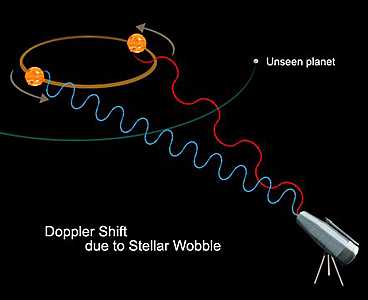Describe a Blue Shift. Mission SM4 pertains to the phenomenon of the Dopper Effect.
Physics Tutorial The Doppler Effect And Shock Waves
Doppler effect is an important phenomenon in various scientific disciplines including planetary science.

. I know what is happening to the wavelengths when an object is blue shifted or red shifted. The Doppler effect causes the received frequency of a source how it is perceived when it gets to its destination to differ from the sent frequency if there is motion that is increasing or decreasing the distance between the source and the receiver. As a star apporaches earth the light waves become more compressed.
Motion toward or away from the observer. This shows up in spectra of stellar light as a shift in the black lines called. The component of relative velocity that lies in the line of sight.
Doppler effect in physics is defined as the increase or decrease in the frequency. The Doppler effect is a change in the pitch of a sound that occurs when the source of the sound is moving relative to the listener. The frequency is shorter as it moves toward you and the object shows a blueshift.
The apparent change in wavelength that occurs when an object is moving. We can use the Doppler effect equation to calculate the radial velocity of an object if we know three things. Doppler effect used by these radas is a physical phenomenon observed in waves emitted or reflected by a source.
They also have a good idea why the Doppler effect occurs. Astronomers use the Doppler effect to measure the frequency of light waves as an object is moving with respect to the observer. When you blow into a clarinet a thin reed begins to vibrate.
It is the change in frequency of a wave corresponding to an observer who is moving relative to the wave source. This is called the Doppler effect. This effect can be observed every time a source wave is moving.
You must answer one question from each Question Group to complete the mission. The phenomenon is called the Doppler effect after Austrian mathematician Christian Johann Doppler who first predicted this odd behavior of sound in 1842. The mission consists of 29 questions organized into 8 Question Groups.
The vibrating reed first pushes against air molecules the medium then pulls away. For particular absorption or emission lines we usually know exactly what wavelength. Doppler effect is the apparent change in the frequency of a wave caused by the relative motion between the observer and the waves source.
The Doppler effect is also called the Doppler shift. Today scientists know that the Doppler effect applies to all types of waves including water sound and light. It is perceived for example when listening to the sound of an ambulance passing by an observer.
As a star moves away from earth the light waves become more expanded. Take a woodwind instrument such as a clarinet. The component of relative velocity that lies in the line of sight.
Doppler Effect works on both light and sound objects. I can explain the difference between blue shift and red shift. The Doppler effect is the apparent shift in wave frequency due to the movement of a wave source.
The Doppler effect describes the change in the observed frequency of a wave when there is relative motion between the wave source and the observer. The apparent change in wavelength or frequency of the radiation from a source due to its relative motion away from or toward the observer. Thus the wavelengths will be shorter.
This effect is readily observable as variation in the pitch of sound between a moving source and a. The Doppler effect has several real-world applications. As the ambulance approaches the tone becomes more and more acute and as it moves away it becomes more serious.
The apparent change in wavelength or frequency of the radiation from a source due to its relative motion away from or toward the observer. Learn about the Doppler Effect. In simple terms if either the source of the sound or an observer or both are in motion with respect to each other then the frequency of sound at its origin will be different from the frequency at the point where it is being observed.
Definition of Doppler effect. This effect was named after the Austrian physicist Christian Doppler who described the Doppler principle in 1842. It was discovered by Christian Johann Doppler who described it as the process of increase or decrease of starlight that depends on the relative movement of the star.
Generally the doppler effect can be defined as the change in wave frequency whether it is light or sound during relative motion between the source of the wave and the observer. The Doppler effect is observed whenever the source of waves is moving relative to an observer. A common example of the Doppler effect in sound is the altering of pitch heard when a bus.
Describe a Red Shift. The speed of light the original unshifted wavelength of the light emitted and the difference between the wavelength of the emitted light and the wavelength we observe. Assignment Type - PA.
Motion toward or away from the observer. The apparent frequency shifts upward when the wave source is approaching and downward when the wave. Doppler effect the apparent difference between the frequency at which sound or light waves leave a source and that at which they reach an observer caused by relative motion of the observer and the wave source.
Once the police car crosses you and goes ahead the sound gradually decreases again. This effect is basically known as the Doppler effect. If the object is moving away it shows a redshift.
It occurs because the frequency of the sound waves changes as the source of sound moves closer to or farther from the listener. Waves emitted by an object traveling toward an observer get compressed prompting a higher frequency as the source approaches the observer. The Doppler effect can be described as the effect produced by a moving source of waves in which there is an apparent upward shift in frequency for observers towards whom the source is approaching and an apparent downward shift in frequency for observers from whom the.
This phenomenon is used in astronomical measurements in Mössbauer effect studies and in radar and modern navigation. A change in the frequency with which waves as of sound or light from a given source reach an observer when the source and the observer are in motion with respect to each other so that the frequency increases or decreases according to the speed at which the distance is decreasing or increasing. This results in an area where all of the air molecules are pressed together and right beside it an area where air molecules are spread far apart.
The Doppler effect or Doppler shift describes the changes in frequency of any kind of sound or light wave produced by a moving source with respect to an observer. For instance when a sound object moves towards you the frequency of the sound waves increases leading to a higher pitch. The Doppler effect or the Doppler shift describes the changes in the frequency of any sound or light wave produced by a moving source with respect to an observer.

Scientists Say Doppler Effect Science News For Students

Explained The Doppler Effect Mit News Massachusetts Institute Of Technology

0 Comments